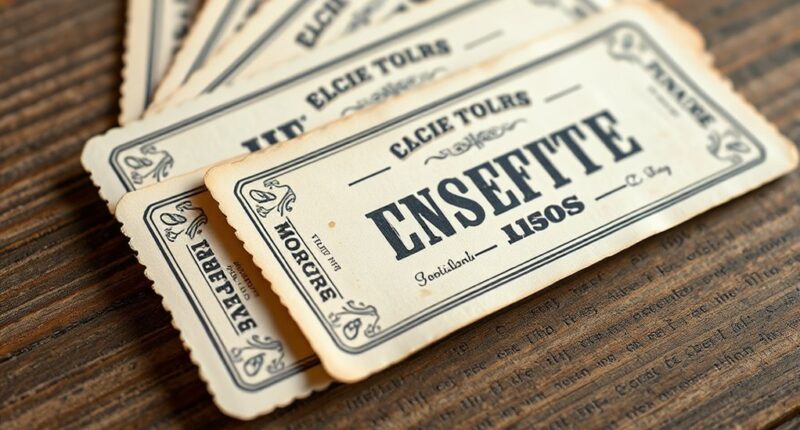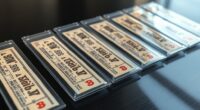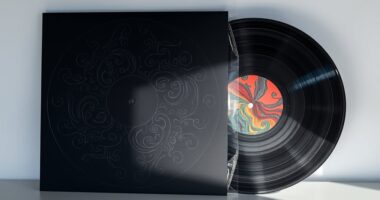To authenticate vintage concert tickets, examine the paper quality—genuine tickets often have thick, textured paper with signs of aging like discoloration or foxing. Check the design details, including era-specific fonts, layout, and printing techniques such as letterpress impressions. Measure the size and look for unique shapes or perforations. Also, verify serial numbers or barcodes, and assess wear patterns and provenance. For more tips, you’ll find helpful insights below.
Key Takeaways
- Examine the paper quality, texture, and aging signs such as discoloration, yellowing, or foxing to verify authenticity.
- Check for era-specific design features, fonts, and layout consistency that match the vintage period.
- Inspect printing techniques like letterpress or lithography, and look for signs of modern reproductions such as blurry images or uneven ink.
- Verify serial numbers, barcodes, and security features against official records or known authentic examples.
- Assess wear patterns, creases, tears, and provenance to distinguish genuine aged tickets from artificially distressed reproductions.
Examining Paper Quality and Material

When examining vintage concert tickets, the paper quality and material reveal much about their origin and age. You’ll notice that older tickets often used thicker, coarse paper, sometimes with a slight texture or grain. Modern reproductions tend to have smoother, thinner paper that feels more uniform. Pay attention to the weight and feel—authentic tickets from decades ago usually have a sturdier, more durable quality. You might also see signs of aging, such as discoloration, yellowing, or minor foxing, which indicate genuine age. Some vintage tickets used specialized paper or cardstock that’s different from today’s mass-produced options. Recognizing these subtle differences can help you determine whether a ticket is truly vintage or a modern reproduction. Additionally, understanding paper composition can further aid in identifying authenticity by analyzing the materials and manufacturing techniques used, and aging signs can provide clues about how long the ticket has been in circulation or storage. For example, examining the printing techniques can offer insights into the period in which the ticket was produced.
Checking Design Consistency and Printing Details

You should carefully examine the font and typography style to guarantee it matches the original design. Check for color consistency and fading, as these can reveal age or reproduction issues. Also, pay attention to the printing techniques and ink used, since authentic tickets often have specific printing characteristics. Additionally, inspecting any security features such as watermarks or holograms can help verify authenticity. Incorporating an understanding of home improvement techniques like proper lighting and display methods can enhance the presentation and preservation of your memorabilia. Recognizing authentication methods can further assist in confirming the ticket’s legitimacy and protecting your collection. Being aware of relationship warning signs can also be useful when evaluating the history behind memorabilia, especially if provenance is uncertain.
Font and Typography Style
Examining the font and typography style on vintage concert tickets reveals how carefully designers balanced readability with artistic flair. Authentic tickets often feature fonts that reflect the era’s design trends, such as bold serif or distinctive script styles. Look for consistent letter spacing and alignment, which indicate quality printing. Pay attention to how the text is arranged; genuine tickets typically have a clear hierarchy, with headings, dates, and venue details distinctly styled. Be wary of inconsistent font sizes, unusual or overly modern typefaces, or uneven letter shapes, as these can signal reproductions. Authentic tickets also often use specific printing techniques, like letterpress or screen printing, which leave subtle impressions or ink textures visible under close inspection. Accurate font choices and consistent typography are key signs of genuine vintage concert memorabilia. Additionally, printing techniques can help distinguish authentic tickets from forgeries.
Furthermore, understanding typography trends from the specific era can assist collectors in verifying authenticity, as certain styles were prevalent during particular decades.
Color Consistency and Fading
Color consistency and fading are crucial indicators of a vintage concert ticket’s authenticity. Genuine tickets often display uniform colors, with consistent shades across all design elements. If you notice uneven coloring, blotches, or areas where the ink has faded unevenly, it could signal a reproduction or a fake. Fading over time is natural, but it occurs gradually and uniformly, especially on older tickets. Look for areas with abrupt color loss or patches that don’t match the overall design. Modern reproductions may have overly vibrant, fresh-looking colors or inconsistent hues that seem out of place for their age. By carefully examining the ticket’s color integrity, you can better determine whether it’s an authentic piece or a reproduction. Additionally, color fading patterns can reveal the ticket’s age and authenticity, as genuine tickets tend to fade predictably over many years. Recognizing printing techniques used in vintage tickets can further aid in authentication, since older printing methods differ from modern digital reproductions. Moreover, consistent ink application throughout the ticket is often a sign of authentic printing, whereas inconsistencies might suggest a forgery. Checking for paper quality can also provide clues, as older tickets are often printed on specific types of paper that differ from modern materials.
Printing Techniques and Ink
Pay close attention to the printing techniques and ink details on a vintage concert ticket, as these can reveal a lot about its authenticity. Authentic tickets often feature specific printing methods, such as letterpress, lithography, or offset printing, which produce distinct textures and edges. Examine the ink for consistency; genuine tickets usually have vibrant, evenly applied ink, while fakes may show smudging, uneven application, or fading. Look for color registration errors or over-inked areas, indicating lower-quality reproduction. Pay attention to the printing sharpness—authentic tickets typically have crisp, clear images and text, whereas counterfeit ones might appear blurry or pixelated. Understanding these printing details helps you spot discrepancies that can reveal a ticket’s true age and originality. Additionally, printing quality can vary based on the era and production process, offering further clues to verify authenticity. Being familiar with common printing techniques enhances your ability to distinguish genuine memorabilia from reproductions. Recognizing the printing process used can also help identify the specific time period when the ticket was produced, adding another layer of verification. A keen eye for print edges and texture differences can also aid in identification.
Analyzing Ticket Size, Shape, and Layout
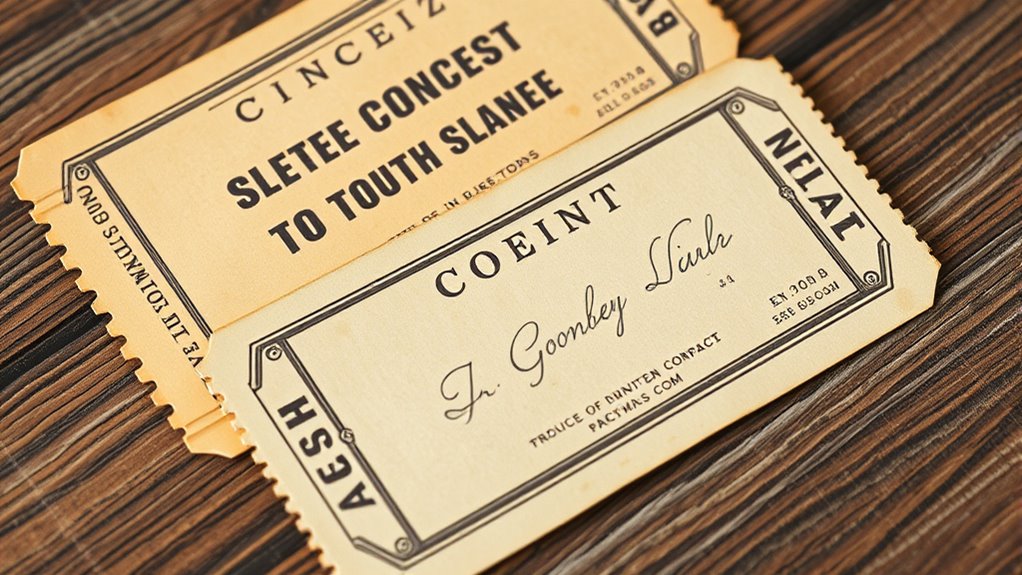
Start by examining the ticket’s dimensions and size to understand its purpose and portability. Next, observe the shape and any cutouts, which can reveal design trends or functional features. Finally, analyze the layout and design elements to see how they guide your eye and enhance the overall look.
Ticket Dimensions and Size
The size and shape of vintage concert tickets often reflect both practical considerations and artistic choices, making them a key aspect of their nostalgic appeal. Typically, tickets range from small, wallet-sized pieces to larger, more elaborate designs, depending on the era and event. Standard dimensions, like 2×5 inches or 3×7 inches, were common, allowing easy handling and storage. Some tickets feature unique proportions or unusual layouts, adding to their collectible appeal. Pay attention to consistency in size and layout, as discrepancies may signal reproductions or alterations. The overall proportions can also hint at the ticket’s authenticity, especially if they align with known design standards from the specific time period. Accurate measurement and comparison help you distinguish genuine vintage tickets from potential fakes. Additionally, understanding the design standards used during different eras can further assist in verifying authenticity.
Shape and Cutouts
Vintage concert tickets often feature distinctive shapes and cutouts that reflect their era and purpose. These design choices help authenticate your memorabilia. Consider these aspects:
- Unique Shapes: Some tickets have rounded edges, scalloped borders, or die-cut forms that match the event’s style.
- Cutouts and Windows: Certain tickets include perforated sections or window cutouts for easy validation or tear-off stubs.
- Size Variations: Ticket dimensions can range from small, wallet-sized pieces to larger, poster-like sizes, indicating their age and significance.
- Layout Symmetry: The arrangement of elements, such as logos, dates, and venue details, often follows specific patterns aligned with the ticket’s style.
Analyzing these features helps distinguish authentic vintage tickets from reproductions or forgeries.
Layout and Design Features
Examining a concert ticket’s size, shape, and layout reveals valuable clues about its authenticity and era. Authentic vintage tickets often have specific dimensions, such as standard rectangular shapes or unique cutouts, reflecting the printing practices of the time. Pay attention to the layout—official tickets typically feature well-organized information, including band names, dates, and venue details, often aligned with consistent spacing. The design style can also indicate its age: bold fonts, intricate borders, or specific color schemes were popular in certain periods. Modern reproductions may mimic these elements but often lack the subtle imperfections or paper quality of originals. By carefully analyzing these layout and design features, you can better determine whether a ticket is genuine vintage memorabilia or a reproduction.
Investigating Ticket Serial Numbers and Barcodes

To understand how ticket authenticity is verified, you need to investigate the serial numbers and barcodes printed on concert tickets. These elements are essential for confirming legitimacy. First, check if the serial number matches the official format used by the event organizer. Second, verify that the barcode scans correctly and links to a valid ticket database. Third, compare the serial number with known authentic tickets from the same event. Fourth, look for inconsistencies such as blurry printing or mismatched fonts, which could indicate a counterfeit. Authentic tickets often have unique, tamper-proof serials and barcodes that integrate with digital ticketing systems. By carefully examining these features, you can better determine whether your vintage ticket is genuine or a forgery.
Assessing Wear, Ageing, and Provenance
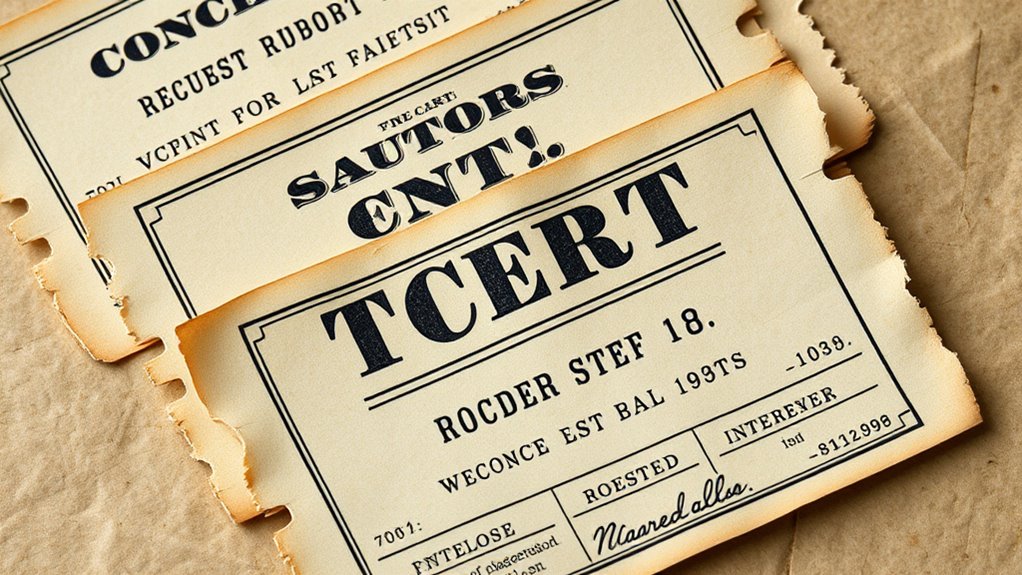
Evaluating wear, aging, and provenance is essential in determining a ticket’s authenticity and historical value. You should closely examine the ticket’s surface for signs of genuine use, such as creases, tears, or fading consistent with age. Authentic tickets often show uneven wear, especially around edges or perforations, indicating handling over time. Check the paper quality—vintage tickets typically have a distinct texture and weight compared to modern reproductions. Verifying provenance involves understanding the ticket’s history and ownership trail, which can add credibility. Be cautious of artificially aged tickets that look uniformly worn or artificially faded. By carefully inspecting these physical aspects, you can better judge whether a ticket is genuinely vintage or a modern fake. This process helps you make informed decisions about its authenticity and worth.
Consulting Experts and Authentication Resources
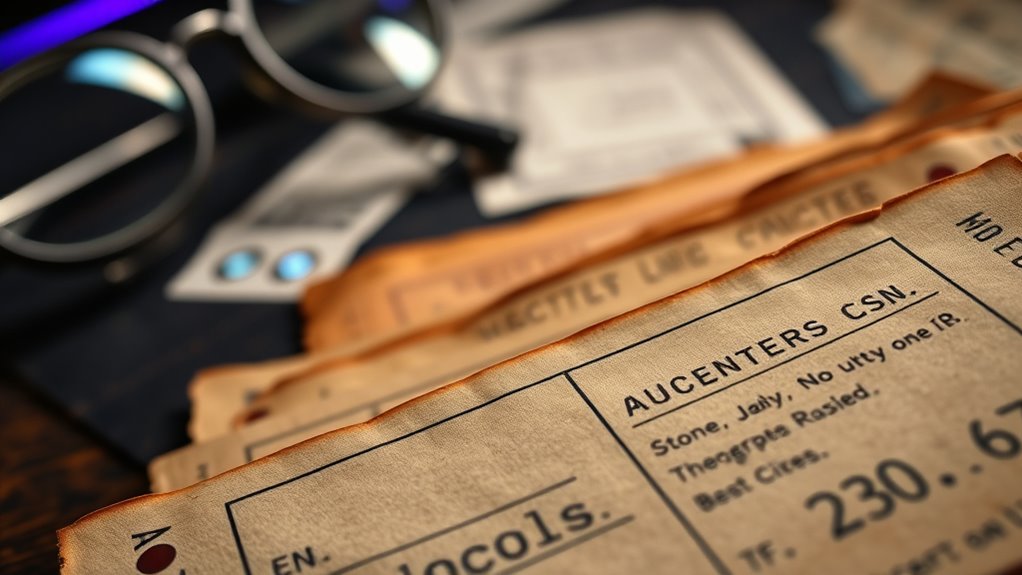
Consulting experts and utilizing authentication resources can considerably enhance your ability to verify vintage concert tickets. These professionals have the experience to spot fakes and understand the nuances of authentic memorabilia. To get started, consider these options:
Consult experts and resources to confidently verify vintage concert tickets’ authenticity.
- Reach out to reputable appraisers specializing in music memorabilia.
- Use online authentication companies with proven credentials.
- Join collector forums and communities to share insights and get feedback.
- Consult auction houses that deal with vintage concert tickets regularly.
Frequently Asked Questions
How Can I Distinguish Between a Genuine Vintage Ticket and a Replica?
You want to tell if a vintage concert ticket is real or a replica. Start by examining the paper quality; genuine tickets often have thick, textured paper. Check the print quality—authentic tickets feature sharp, vibrant ink, and consistent fonts. Look for age signs like slight discoloration or wear. Research the event’s ticket design and compare it with known authentic examples. Trust your instincts and when in doubt, consult a memorabilia expert.
Are There Specific Brands or Publishers Known for Authentic Vintage Concert Tickets?
Did you know that authentic vintage concert tickets often come from well-known publishers like Ticketron and Ticketmaster? You’ll want to look for tickets printed by these reputable sources, as they’re more likely to be genuine. Pay attention to the ticket’s design, paper quality, and printing details. Sometimes, brands like Ticketron have distinctive fonts or logos that can help you verify authenticity, giving you confidence in your collection.
What Are Common Signs of Forgery or Counterfeit Ticket Production?
When checking if a ticket is real or counterfeit, look for signs like blurry printing, uneven fonts, or mismatched colors. Examine the paper quality—authentic tickets often use thicker, textured paper. Check for consistent perforations and official logos that are clear and well-printed. Be wary of obvious typos or poor alignment. If something seems off, compare it to verified tickets or consult a memorabilia expert for confirmation.
How Does Environmental Damage Affect the Authenticity of Paper Memorabilia?
A picture is worth a thousand words, and environmental damage can tell you plenty about a paper’s authenticity. If your memorabilia shows signs of water stains, fading ink, or torn edges, it might be a fake or poorly preserved. Exposure to sunlight or moisture accelerates deterioration, making it harder to verify originals. Protect your collection by storing items in controlled environments, because a damaged piece might tell a different story than the true history behind it.
Can Digital Scans Accurately Verify the Authenticity of Physical Tickets?
You might wonder if digital scans can reliably verify a ticket’s authenticity. While scans help you examine details like printing quality and design, they can’t replace physical analysis or expert authentication. Digital images lack tactile cues, paper age, and subtle marks, so use scans as a helpful tool alongside expert opinions. Always combine digital verification with hands-on inspection for the most accurate assessment of your vintage concert ticket.
Conclusion
By carefully examining paper quality, design details, serial numbers, and age signs, you can confidently authenticate vintage concert tickets. Consulting experts can further verify their authenticity and history. Remember, isn’t it worth knowing the true story behind your memorabilia? Taking these steps guarantees you preserve genuine pieces of music history and avoid fakes. So, next time you come across a ticket, will you trust your eye or leave it to the experts?
